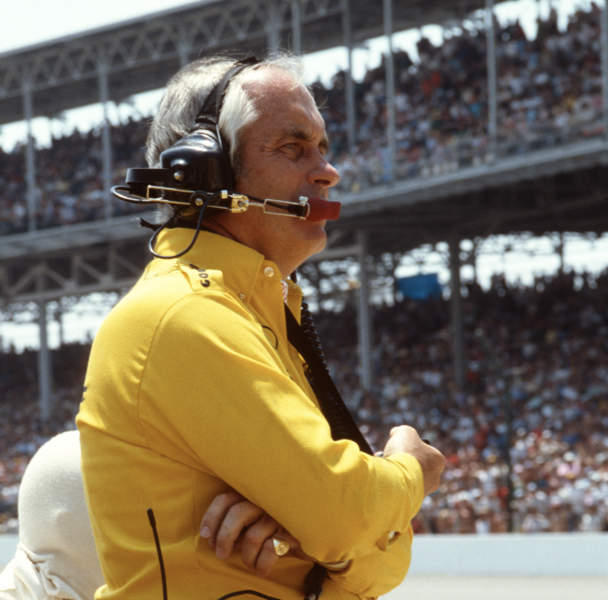
By Preston Lerner
Racing, so the saying goes, is a great way to turn a big fortune into a small one. Unless, that is, you're Roger Penske, a man who's made a career out of standing convention on its ear. Penske was only 27 years old, seemingly at the height of his powers, when he hung up his driving suit to concentrate on the business of business. Today, he commands a vast corporate empire that embraces more than 13,000 employees. More to the point, he remains the captain of Penske Racing, perhaps the most dominant race team in American history.
Behind the wheel, Penske was talented enough to be honored as the Sports Car Driver of the Year by Sports Illustrated, The New York Times and the LosAngeles Times. But even then, he aspired to be more than the next Fangio. "I don't want to be known as a race driver," he told a reporter a year before he retired and he isn't. Today, Penske is remembered best as the man whose cars have won ten Indy 500s; two Can-Am championships; three Trans-Am titles; numerous Winston Cup races; and one of only three Formula I Grands Prix won by an American team. Hes also a founding director of CART, a principal of Ilmor Engineering, the owner of two major racetracks and a constructor in his own right.
Few men have cast as large a shadow over their respective fields as Penske. Even as a privateer, he always insisted that his cars look impeccable. And nobody ever earned the Unfair Advantage as often as he did, whether it be by turning a Formula I wreck into a world-beating sports car, building special refueling rigs for lighting-fast Trans-Am pit stops, introducing turbocharging to the Can-Am series, or developing an entirely new engine to win a single race the 1994 Indy 500.
Born in Shaker Heights, Ohio, in 1937, the son of a corporate executive, Penske started racing sports cars before graduating from Lehigh University. He won numerous races and several SCCA championships while driving a wide variety of machinery, Jags, Porsches, Coopers, Maseratis, Ferraris, Corvette Grand Sports and Chaparrals. But it was with a mongrel known as the Zerex Special that Penske achieved his greatest notoriety.
A wrecked Formula I car transformed into a two-seat sports racer, the Zerex Special met the letter if not the spirit of the law. With it, Penske blitzed the fields at Riverside and Laguna Seca to win the country's premier sports car races of 1962. Coupled with two more victories in Puerto Rico and Nassau, Penske pocketed $34,350 a princely sum by the standards of the day. At the same time, he also pointed the way toward a new era of major-league corporate sponsorship.
In 1964, Penske retired from driving after scoring back-to-back wins in Nassau in a Grand Sport and a Chaparral. Two years later, he returned to racing as an entrant. Although the team's debut at Sebring in 1966 with al obsolete Grand Sport was inauspicious, Penske soon bought a Lola T70 and hired Mark Donohue as his fulltime driver.
In Donohue, the Brown University engineering graduate, Penske found the perfect foil. Usually racing in irreproachable Sunoco livery, the two men dominated Trans-Am (in Camaros and later Javelins) and Can-Am (in the Porsche 917-10 and 917-30 Turbopanzers) racing so comprehensively that neither series was ever the same again. At the 24 Hours of Daytona in 1969, they scored Lola's first long-distance victory. Turning next to Indy cars, they won the 1972 edition of the 500.
In 1974, with little left to conquer here in the States, Penske created Penske Cars Ltd. in Poole, England, and went Grand Prix racing. The Formula I adventure was an unhappy one, reaching its low ebb when Donohue was killed in a practice crash in 1975. Although John Watson gave the PC4 a historic victory in the Austrian Grand Prix in 1976, Penske shut down his Fl operation at the end of the season and concentrated his efforts on Indy cars.
Since then, nobody has done it better. With a stable of champions that includes Rick Mears (a Penske discovery), Emerson Fittipaldi, Mario Andrctti, Tom Sneva, Danny Sullivan, Paul Tracy (another Penske find) and Bobby, Al and Al Unser Jr., Penske Racing posted 91 wins, 114 poles and nine CART championships through the end of the 1994 season. Meanwhile, Rusty Wallace scored another 18 Winston Cup victories in Penske Racing South cars. And now, of course, Roger Penske is being inducted into the Motorsports Hall of Fame.